Wildfire Impacts on Slope Stability Triggering in Mountain Areas
Abstract
1. Introduction
2. Materials and Methods
2.1. The Terrain Water-Balance Model
2.2. Ardenno (IT) and Ronco Sopra Ascona (CH) Case Studies
2.3. Model Settings
3. Results and Discussion
Discussion
4. Conclusions
Author Contributions
Funding
Acknowledgments
Conflicts of Interest
References
- Albano, R.; Mancusi, L.; Abbate, A. Improving flood risk analysis for effectively supporting the implementation of flood risk management plans: The case study of “Serio” Valley. Environ. Sci. Policy 2017, 75, 158–172. [Google Scholar] [CrossRef]
- Tropeano, D.; Curtarello, M.; Godone, F.; Turconi, L. Colate detritiche dell’estate 1998 in Ardenno (Bassa Valtellina—SO). NIMBUS-TORINO- 1997, 5, 48–61. [Google Scholar]
- Ballio, F.; Brambilla, D.; Giorgetti, E.; Longoni, L.; Papini, M.; Radice, A. Evaluation of sediment yield from valley slope: A case study. WIT Trans. Eng. Sci. 2010, 67, 149–160. [Google Scholar]
- Longoni, L.; Ivanov, V.I.; Brambilla, D.; Radice, A.; Papini, M. Analysis of the temporal and spatial scales of soil erosion and transport in a Mountain Basin. Ital. J. Eng. Geol. Environ. 2016, 16, 17–30. [Google Scholar]
- Papini, M.; Ivanov, V.I.; Brambilla, D.; Arosio, D.; Longoni, L. Monitoring bedload sediment transport in a pre-alpine river: An experimental method. Rend. Online Soc. Geol. Italy 2017, 43, 57–63. [Google Scholar] [CrossRef]
- Montrasio, L. Stability of soil-slip. Risk Analysis II. WIT Trans. Eng. Sci. 2000, 45, 357–366. [Google Scholar]
- Montrasio, L.; Valentino, R. Valentino Modelling Rainfall-induced Sahllow Landslides at Different Scales Using SLIP—Part 1. Proced. Eng. 2016, 158, 476–481. [Google Scholar] [CrossRef]
- Iverson, R.M. Landslide triggering by rain infiltration. Water Resour. Res. 2000, 36, 1897–1910. [Google Scholar] [CrossRef]
- Greppi, M. Idrologia; Hoepli: Milano, Italy, 2005. [Google Scholar]
- Ozturk, U.; Tarakegn, Y.A.; Longoni, L.; Brambilla, D.; Papini, M.; Jensen, J. A simplified early-warning system for imminent landslide prediction based on failure index fragility curves developed through numerical analysis. Geomat. Nat. Hazards Risk 2016, 7, 1406–1425. [Google Scholar] [CrossRef]
- Robichaud, P. Fire effects on infiltration rates after prescribed fire in Northern Rocky Mountain forests, USA. J. Hydrol. 2000, 231, 220–229. [Google Scholar] [CrossRef]
- Conedera, M.; Peter, L.; Marxer, P.; Forster, F.; Rickenmann, D.; Re, L. Consequences of forest fires on the hydrogeological response of mountain catchments: A case study of the Riale Buffaga, Ticino, Switzerland. Earth Surf. Process. Landf. 2003, 28, 117–129. [Google Scholar] [CrossRef]
- Caine, N. The Rainfall Intensity—Duration Control of Shallow Landslides and Debris Flows. Geogr. Ann. Ser. A, Phys. Geogr. 1980, 62, 23–27. [Google Scholar]
- Ceriani, M. Rainfall thresholds triggering debris-flow in the alpine area of Lombardia Region, central Alps—Italy. In Proceedings of the First International Congress for the Protection and Development of Mountain Environment, Bern, Switzerland, 1992. [Google Scholar]
- Longoni, L.; Papini, M.; Arosio, D.; Zanzi, L. On the definition of rainfall thresholds for diffuse landslides. Landslides 2011, 1, 27–43. [Google Scholar]
- De Michele, C.; Rosso, R.; Rulli, M.C. Il regime delle precipitazioni intense sul territorio della Lombardia. Milan: ARPA Lomb. 2005, 1, 1–73. [Google Scholar]
- ARPA Lombardia. Rete Monitoraggio Idro-Nivo-Meteorologico. Available online: http://www.arpalombardia.it/stiti/arpalombardia/meteo (accessed on 24 September 2019).
- Hyde, K.D.; Riley, K.; Stoof, C. Uncertainties in Predicting Debris Flow Hazard Following Wildfire. Nat. Hazard Uncertain. Assess. 2017, 223, 287–299. [Google Scholar]
- Munda, S.; Tresoldi, G.; Longoni, L.; Arosio, D.; Papini, M.; Zanzi, L. A customized resistivity system for monitoring saturation and seepage in earthen levees: Installation and validation. Open Geosci. 2017, 9, 457–467. [Google Scholar]
- Cannon, S.H.; Gartner, J.E.; Holland-Sears, A.; Thurston, B.M.; Gleason, J.A. Debris-Flow response of basins burned by the 2002 coal seam and missionary ridge fires, Colorado. Assoc. Eng. Geol. Spec. Publ. 2003, 14, 1–31. [Google Scholar]
- Parise, M.; Cannon, S.H. Wildfire impacts on the processes that generate debris flow in burned watersheds. Nat. Hazards 2012, 1, 217–227. [Google Scholar] [CrossRef]
- Rulli, M.C.; Rosso, R.; Bocchiola, D. Transient catchment hydrology after wildfires in a Mediterranean basin: Runoff, sediment and woody debris. Hydrol. Earth Syst. Sci. 2007, 11, 125–140. [Google Scholar]
- Stoof, C.R.; Vervoort, R.; Iwema, J.; Elsen, E.V.D.; Ferreira, A.J.D.; Ritsema, C.J. Hydrological response of a small catchment burned by experimental fire. Hydrol. Earth Syst. Sci. 2012, 16, 267–285. [Google Scholar] [CrossRef]
- Larson-Nash, S.S.; Robichaud, P.R.; Pierson, F.B.; Moffet, C.A.; Williams, C.J.; Spaeth, K.E.; Brown, R.E.; Lewis, S.A. Recovery of small-scale infiltration and erosion after wildfires. J. Hydrol. Hydromech. 2018, 66, 261–270. [Google Scholar] [CrossRef]
- Dragičević, N.; Karleuša, B.; Ožanić, N. Erosion Potential method (Gavrilovic Method) Sensitivity Analysis. Soil Water Resour. 2017, 12, 51–59. [Google Scholar] [CrossRef]
- Giraud, R.E.; McDonald, G.N. The 2000–2004 Fire related debris flow in northern Utah. In Proceedings of the 1st North American Landslide Conference, Vail, CO, USA, 3–8 June 2007; pp. 1522–1531. [Google Scholar]
- Radice, A.; Longoni, L.; Papini, M.; Brambilla, D.; Ivanov, V.I. Generation of a Design Flood-Event Scenario for a Mountain River with Intense Sediment Transport. Water 2016, 8, 597. [Google Scholar] [CrossRef]
- Ma, Q.; Bales, R.C.; Rungee, J.P.; Goulden, M. Vegetation water use responses to forest fires in the Sierra Nevada, California using remote sensing. In Proceedings of the American Geophysical Union, Fall Meeting 2018, Washington, DC, USA, 10–14 Dcember 2018. [Google Scholar]
- Stull, R. Meteorology for Scientist and Engineers, 3rd ed.; The University British Columbia: Vancouver, BC, Canada, 2017; ISBN 978-0-88865-178-5. [Google Scholar]
- Fisher, D.K.; Pringle, H.C., III. Evaluation of alternative methods for estimating reference evapotranspiration. Agric. Sci. 2013, 4, 51–60. [Google Scholar] [CrossRef]
- Milan, V.; Andjelko, S. Determination of Hydraulic Conductivity of Porous Media from Grain-size Composition; Water Resources Publications: Littleton, CO, USA, 1992; ISBN 0918334772. [Google Scholar]
- Menafoglio, A.; Guadagnini, A.; Secchi, P. A kriging approach based on Aitchison geometry for the characterization of particle-size curves in heterogeneous aquifers. Stoch. Environ. Res. Risk Assess. 2014, 28, 1835–1851. [Google Scholar] [CrossRef]
- Wang, J.P.; François, B.; Lambert, P. Equations for hydraulic conductivity estimation from particle size distribution: A dimensional analysis. Water Resour. Res. 2017, 53, 8127–8134. [Google Scholar] [CrossRef]
- Hengl, T.; de Jesus, J.M.; Heuvelink, G.B.; Gonzalez, M.R.; Kilibarda, M.; Blagotić, A.; Shangguan, W.; Wright, M.N.; Geng, X.; Bauer-Marschallinger, B.; et al. SoilGrids250m: Global Gridded Soil Information Based on Machine Learining. PLoS ONE 2016, 12, e0169748. [Google Scholar] [CrossRef] [PubMed]
- Hengl, T.; de Jesus, J.M.; MacMillan, R.A.; Batjes, N.H.; Heuvelink, G.B.; Ribeiro, E.; Samuel-Rosa, A.; Kempen, B.; Leenaars, J.G.; Walsh, M.G.; et al. SoilGrids1km-Global Soil Information Based on Automated Mapping. PLoS ONE 2014, 9, e105992. [Google Scholar] [CrossRef]
- European Environment Agency. CORINE Land Cover (CLC); EU: Copenhagen, Denmark, 2006; ISBN 92-826-2579-6. [Google Scholar]
- Allen, R.G.; Pereira, L.S.; Raes, D.; Smith, M. Crop Evapotranspiration; FAO: Rome, Italy, 1998; p. D05109. [Google Scholar]
- Settore per la Prevenzione del Rischio Geologico, Meteorologico e Sismico. L’evento Alluvionale del 28–29 Giugno 1997 in Piemonte; Regione Piemonte: Torino, Italy, 1997. [Google Scholar]
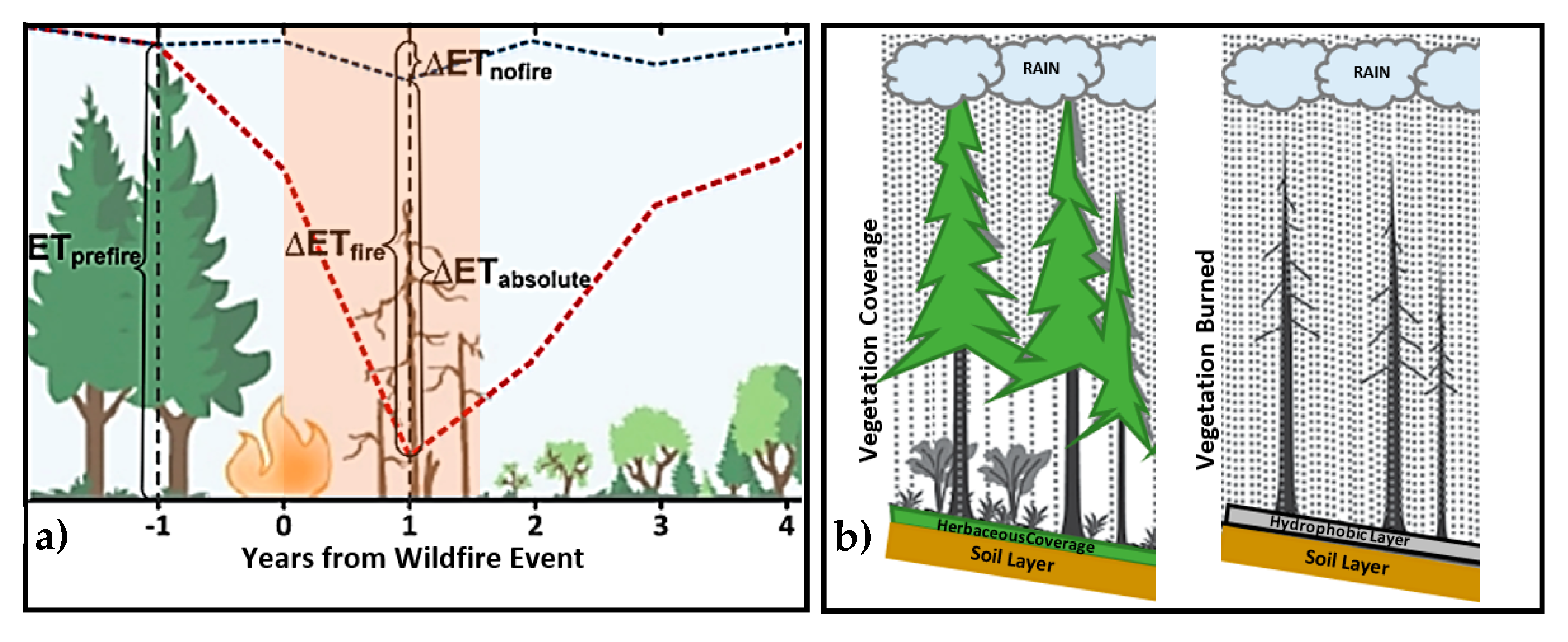
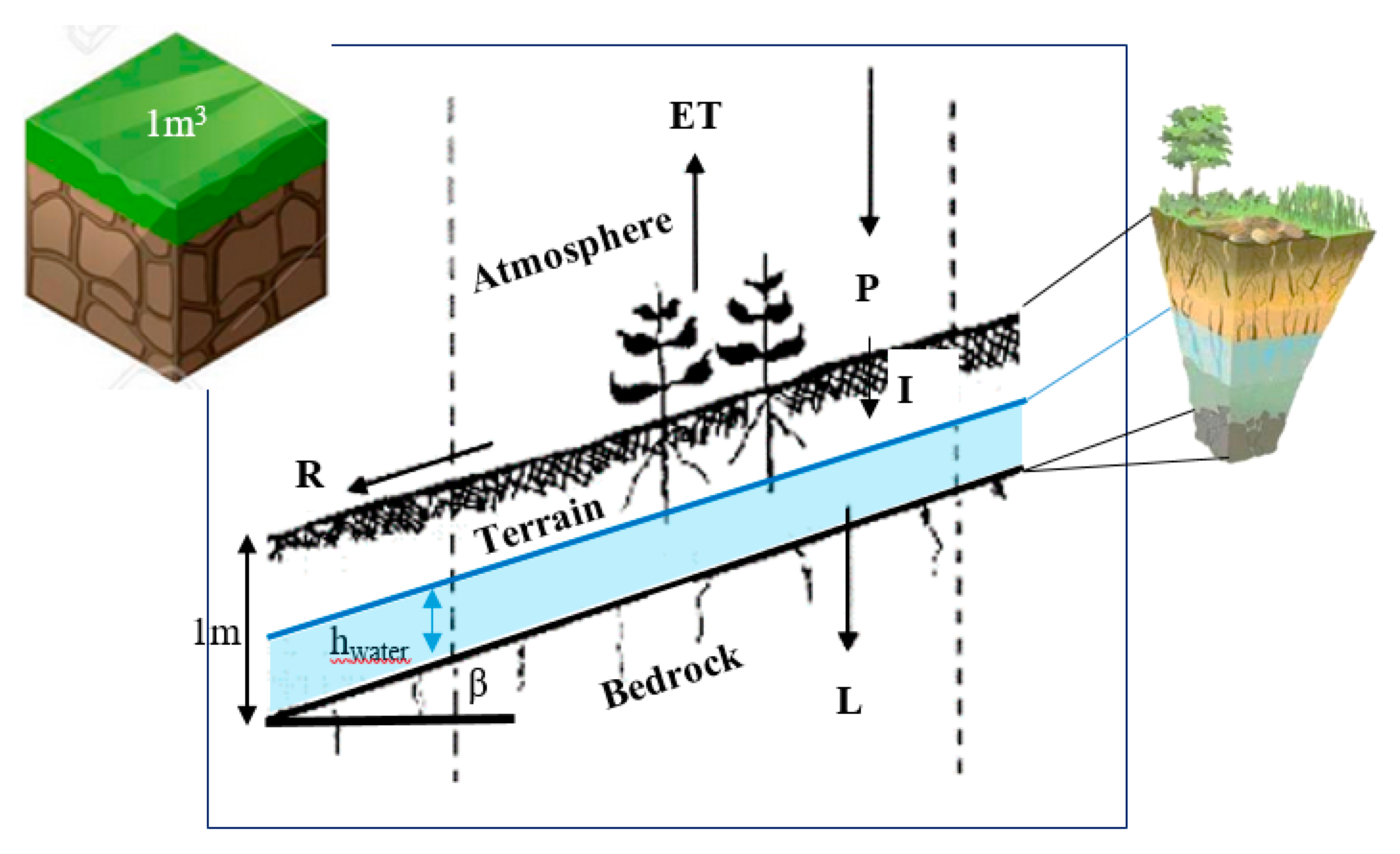

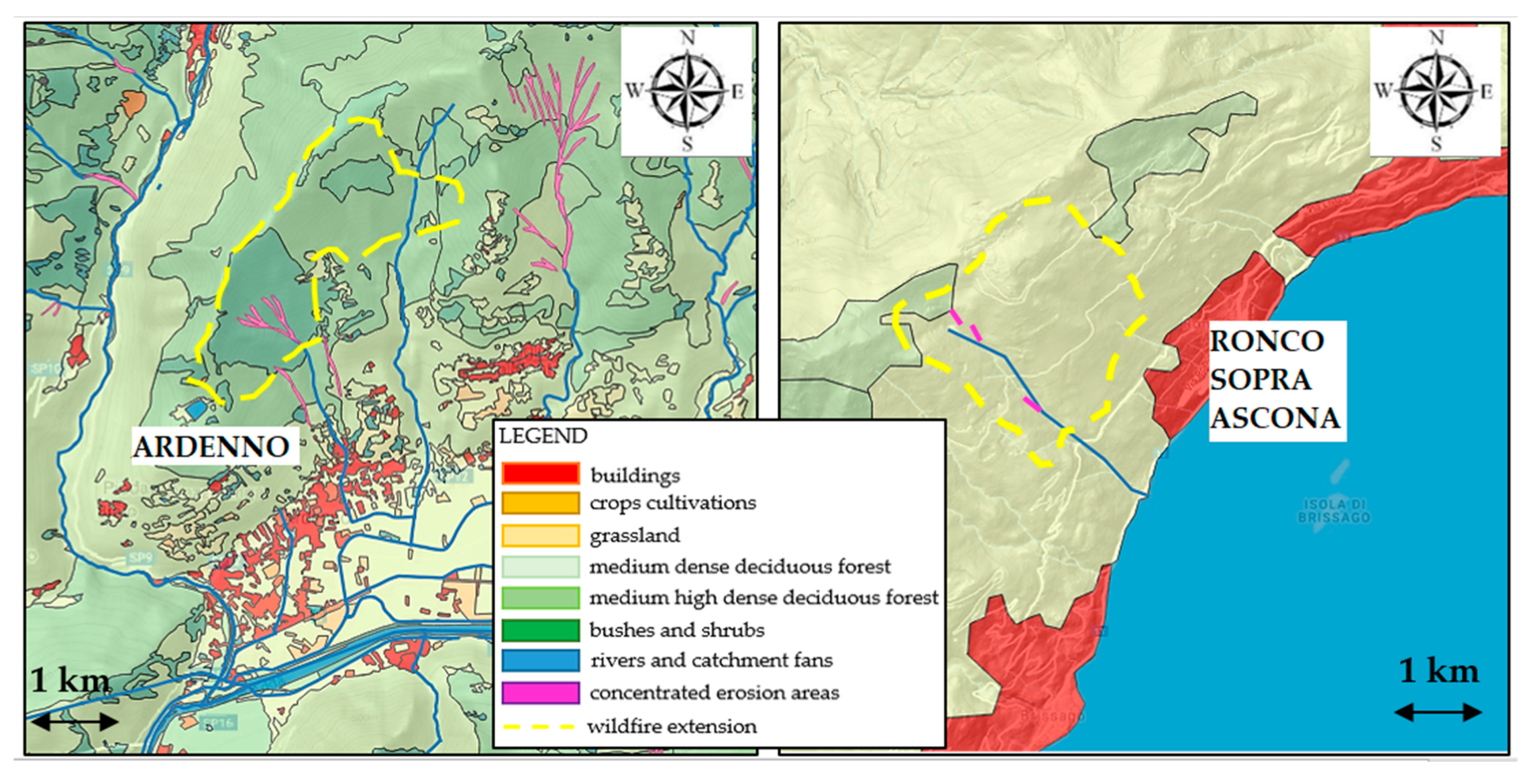
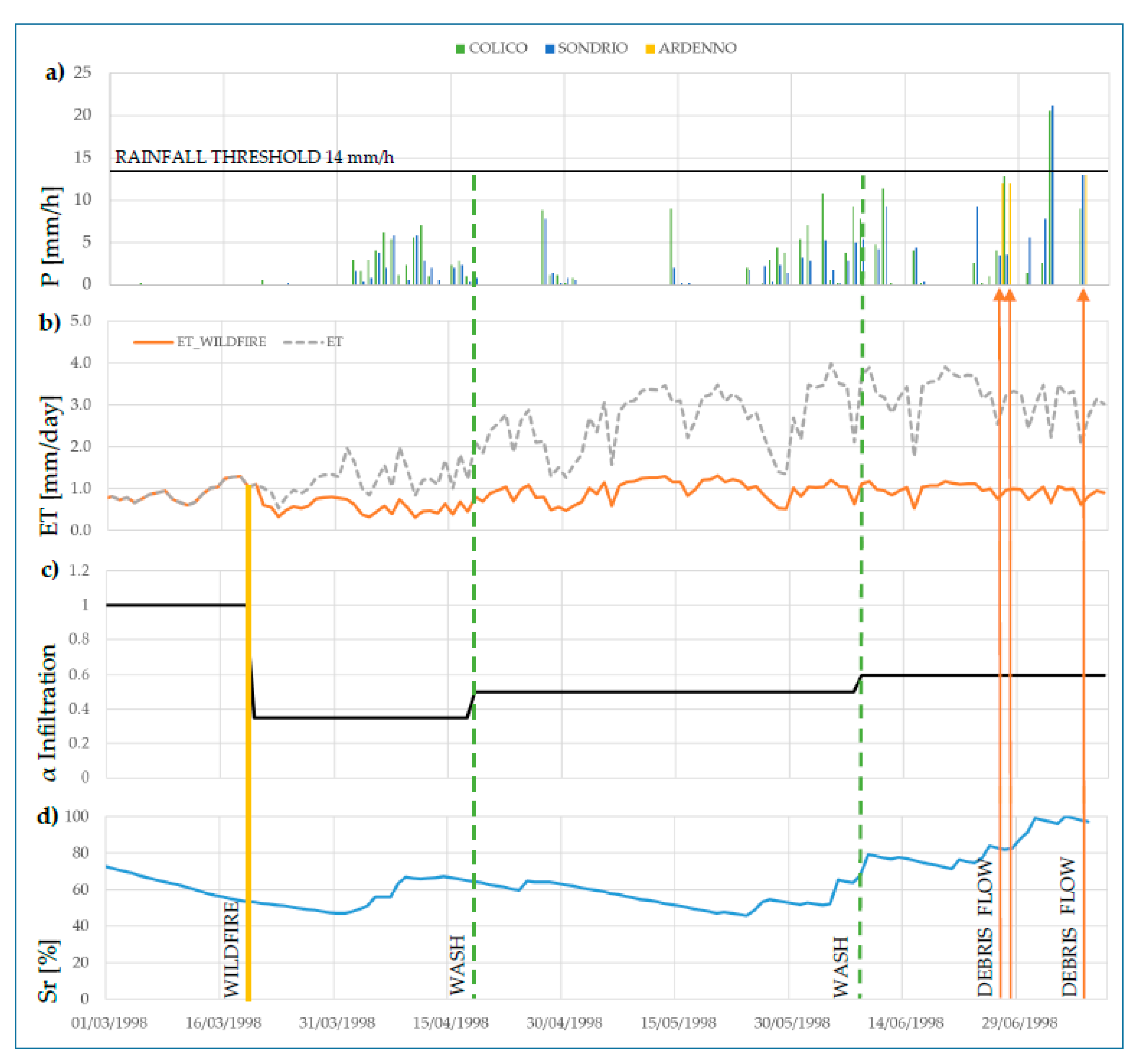
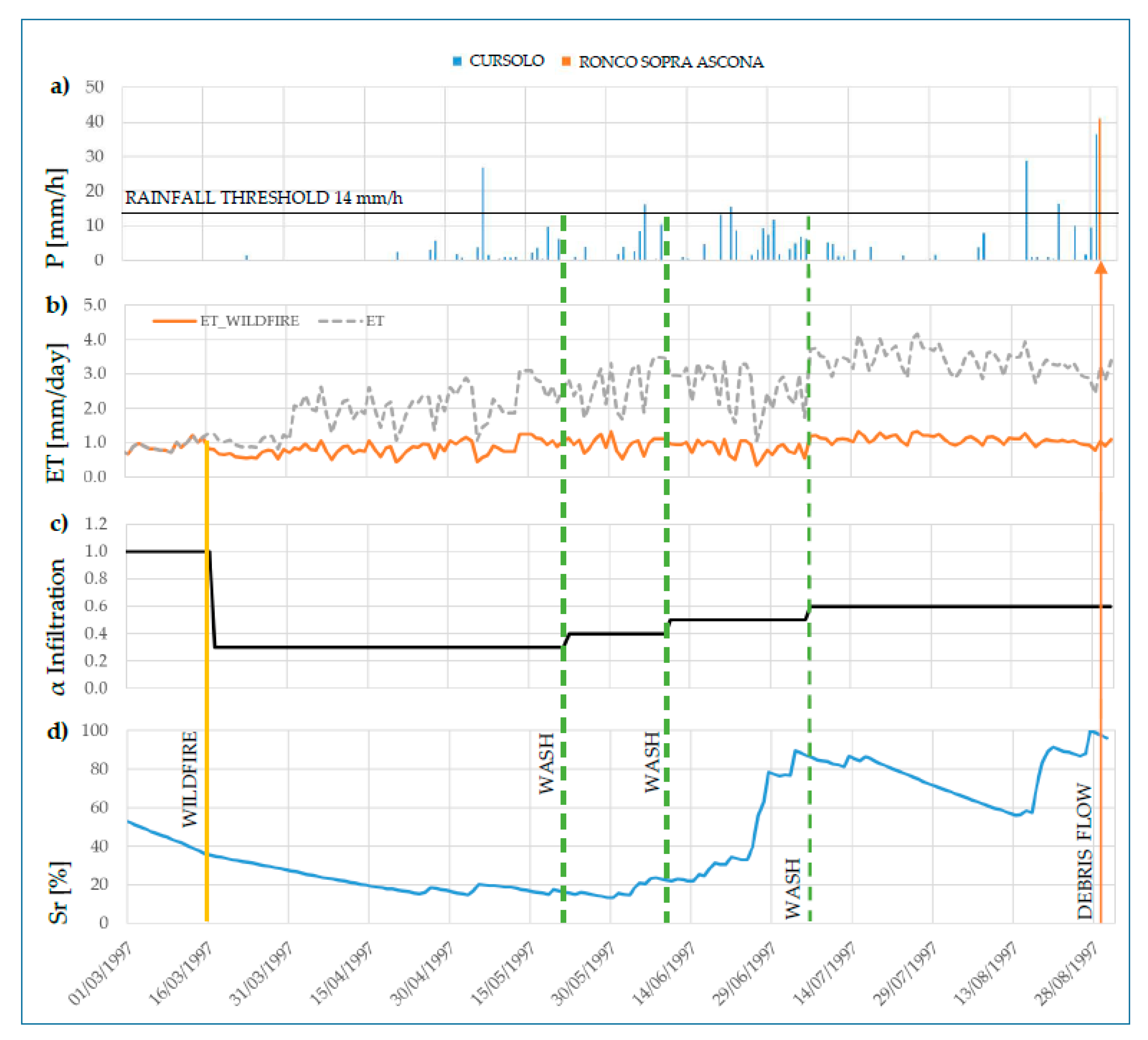
| Calibration Data | Ardenno (IT) | Ronco Sopra Ascona (CH) |
|---|---|---|
| Soil Type | Sandy Loam | Sandy Loam |
| Porosity ϕ [%] | 0.40 | 0.42 |
| Effective Porosity ϕe [%] | 0.23 | 0.25 |
| Saturated Permeability Ks [m/s] | 10−5 | 10−5 |
| Weather Station Location | Ruschedo | Locarno |
| Pluviometer [mm] Time Step | 1 day | 1 day |
| Thermometer [°C] Time Step | 1 day | 1 day |
| Altitude | 800 m | 200 m |
| Start Model Calibration | 1 March 1997 | 1 March 1996 |
| End Model Calibration | 28 February 1998 | 28 February 1997 |
| Start Model Simulation | 1 March 1998 | 1 March 1997 |
| End Model Simulation | 10 July 1998 | 31 August 1997 |
| Wildfire Event | 20 March 1998 | 15 March 1997 |
© 2019 by the authors. Licensee MDPI, Basel, Switzerland. This article is an open access article distributed under the terms and conditions of the Creative Commons Attribution (CC BY) license (http://creativecommons.org/licenses/by/4.0/).
Share and Cite
Abbate, A.; Longoni, L.; Ivanov, V.I.; Papini, M. Wildfire Impacts on Slope Stability Triggering in Mountain Areas. Geosciences 2019, 9, 417. https://doi.org/10.3390/geosciences9100417
Abbate A, Longoni L, Ivanov VI, Papini M. Wildfire Impacts on Slope Stability Triggering in Mountain Areas. Geosciences. 2019; 9(10):417. https://doi.org/10.3390/geosciences9100417
Chicago/Turabian StyleAbbate, Andrea, Laura Longoni, Vladislav Ivov Ivanov, and Monica Papini. 2019. "Wildfire Impacts on Slope Stability Triggering in Mountain Areas" Geosciences 9, no. 10: 417. https://doi.org/10.3390/geosciences9100417
APA StyleAbbate, A., Longoni, L., Ivanov, V. I., & Papini, M. (2019). Wildfire Impacts on Slope Stability Triggering in Mountain Areas. Geosciences, 9(10), 417. https://doi.org/10.3390/geosciences9100417







